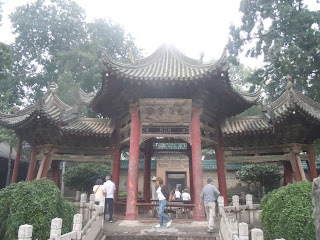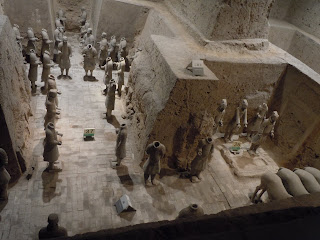First off, Happy Mid-Autumn Festival! 祝你中秋节快了!The Mid-Autumn Festival is a lunar harvest festival, so it's exact date rotates on our Gregorian calendar. It fell on Monday, September 12, this year. All of the Chinese students got the day off, but lucky us, we still had Chinese class (I felt kind of bad for our teachers, since they had to still work on the national holiday). During the Mid-Autumn Festival, it's customary to give mooncakes (月饼) to family members, good friends, or people who you look up to / want to especially thank. It's been explained as more or less equivalent to Thanksgiving, and families who live close enough will often get together for a meal to celebrate. However, this holiday only has a one-day break, so there isn't too much time to travel for college students or working children who are far away from home. A lot of firecrackers were exploded on the streets, though apparently that's not a normal custom...
Last Friday, we visited the Muslim District (回民街) within the city walls. 回民 literally means "Hui people" and refers to the Hui ethnic minority in China, and 街 just means "street"; the Hui people are both marked by their adherence to Islam and ethnic history from Central Asia. (However, the Hui people should not be confused with the Uighur people, another ethnic minority with ties to Islam and Central Asia. We'll meet a lot of Uighur people during our Silk Road trip to Xinjiang province.) We went to the Great Mosque and were lucky enough to have a Hui tour guide who had a good command of English (but also spoke Chinese slowly and articulately enough that I could follow along somewhat). He talked a bit about the history of Islam and the Hui people in China and then transitioned to current issues, such as 9/11 and feelings toward the Chinese state and the Middle East Spring.
Apparently one of the main differences between the Hui and Uighur people is sense of allegiance to China. The Hui people have strong loyalty to the Chinese state and sense of Chinese pride, whereas the Uighur people have a strong (or at least percieved to be strong) sense of separatism and desire to create their own state, or perhaps rejoin with Central Asian former-Soviet states. Also, during the Cultural Revolution, the Great Mosque was shut down but spared from destruction; a lot of people think it's because of the Hui people's support of Zhou Enlai during the fight between the PLA and the KMT. He talked about 9/11 a bit to explain how Islamists (and many other peaceful Muslims) see America's support of Israel as unfair, to try to put it concisely. About the Middle East Spring, he talked about how all people (Chinese, Muslim, whatever) support democratic initiatives and oppose authoritarian rule.
The grounds of the Great Mosque were beautiful, as they were a mix of traditional Chinese and Islamic architecture and style. It had been raining most of the day before we got to the Mosque, so there was a lot of mist still hanging in the air, so the pictures aren't as clear as they could be. The grounds have four main areas; additionally there is a large prayer hall (which we couldn't enter obviously) and school rooms to help teach children the Koran and, more recently, Arabic. Many Muslims in China don't know any Arabic, but, like many Muslims worldwide, still recite prayers in Arabic and may know how to "read" some verses from the Koran.
Entrance to the first courtyard
Characters read 析求和平,roughly "Analyze and Search for Peace"
Archictecture within the third courtyard. There was an altar in the middle...
After walking around the mosque, we had free time to explore the street markets. A lot of people had fun bargaining with the street vendors and haggling for goods. Andras and I separated from the group and just walked around and bought some food eventually. We had some sort of quesadilla-like food. We also ordered some drinks, but Andras unfortunately got a warm corn drink; luckily my "strange fruit" drink was both chilled and good tasting.
A night shot of the street at night. It's a bit smoky from the cooking food and all the cigarettes...
........................................................................................
On Tuesday (09.13), we finally went to see the Terracotta Army outside of Xian. Yet again, it was a somewhat rainy day, so we all hoped most of the museum would be indoors. Luckily it was, and the rain stopped basically once we got there. The Terracotta Army was buried beside some mountains, which I didn't see until our walk back to the bus; the rainy mist obscured a lot of them unfortunately, so I couldn't get a good picture.
So a brief background on the Terracotta Army. The first emperor of unified China, Qin Shihuang (秦始皇) set out to construct a large mausoleum; the design greatly resembled the pyramids of Egypt. The Terracotta Army (兵马俑) was constructed to guard Qin Shihuang in the afterlife; apparently Chinese customs beforehand were to actually kill people and bury them alongside the kings for the afterlife, so the Terracotta Army was a shift in funerary customs, though a few high ranking officials and workers were still killed and buried when Qin Shihuang died. Unfortunately, about three years after the tomb was sealed, it was raided, presumably to both reuse all the weapons buried and to send a political message. Because of this wanton invasion (and time) every warrior was somewhat destroyed when they were rediscovered in 1974. The warriors also were painted rather vibrantly when they were made over 2,000 years ago, but the paint has since either disappeared completely or rubbed off onto the earth packed around the warriors. Some areas have not been excavated in the hopes of gaining better technology and excavation methods to retain the paint on the warriors.
So a brief background on the Terracotta Army. The first emperor of unified China, Qin Shihuang (秦始皇) set out to construct a large mausoleum; the design greatly resembled the pyramids of Egypt. The Terracotta Army (兵马俑) was constructed to guard Qin Shihuang in the afterlife; apparently Chinese customs beforehand were to actually kill people and bury them alongside the kings for the afterlife, so the Terracotta Army was a shift in funerary customs, though a few high ranking officials and workers were still killed and buried when Qin Shihuang died. Unfortunately, about three years after the tomb was sealed, it was raided, presumably to both reuse all the weapons buried and to send a political message. Because of this wanton invasion (and time) every warrior was somewhat destroyed when they were rediscovered in 1974. The warriors also were painted rather vibrantly when they were made over 2,000 years ago, but the paint has since either disappeared completely or rubbed off onto the earth packed around the warriors. Some areas have not been excavated in the hopes of gaining better technology and excavation methods to retain the paint on the warriors.
Rough panorama of the Terracotta Warriors
Close-up of warriors from Pit 1 (一号坑)
Close-up of warriors from Pit 2 (二号坑)
I imagine most of the warriors resembled this when first excavated
I imagine most of the warriors resembled this when first excavated
I think they look more intimidating without heads







No comments:
Post a Comment